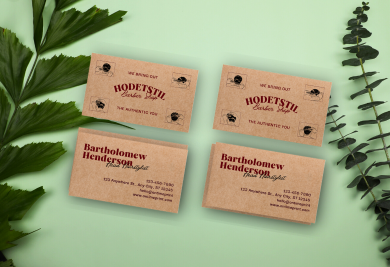Name cards are an important tool for personal and business networking. They provide basic information about a person or company and serve as a first impression when you meet someone new. Knowing the key things to include on a name card can help you make the best impression and stand out from the crowd. In this article, we will discuss the key things to know about name card printing including the design and preparation of the file.
1. Information Essentials

Size:
The first thing is setting the size of the name card. A standard name card is 9 x 5.4 cm.
Details:
A name card should typically include your full name, job title, company name, contact details (phone number, email address, and/or website), social media handles and any relevant logos or symbols. Keep the information on your name card concise and relevant, as the card should serve as a quick reference for your potential contacts.
2. Design Essentials
Fonts & Colors:
Ensure that the design of your name card aligns with your personal or corporate brand. Using the same fonts, colours, and logos as those used in your other marketing materials helps create a cohesive visual identity that will be easily recognizable to others.
Simplicity & Legibility:
Keep the design simple and uncluttered. Too much information or a busy design can make your card difficult to read and less memorable. Keeping only relevant information allows the information on your name card to be easily readable and quickly processed.
Always choose a font style that is clear and easy to read, and that is appropriate for your industry. The font size should also be large enough to read to effectively communicate the details on your name card.
Orientation:
You can use either portrait or landscape orientation. Landscape orientation is most common for name card designs. Make sure your design is created based on the orientation you want.
Material:
The material used for your name card should reflect the quality of your brand. Choosing the right paper, thickness, weight and coating will contribute to the message you’re communicating with the name cards.
Customisation:
Adding special finishings such as spot UV or hot stamping to name cards will make your name cards stand out and leave a lasting impression.
3. Print Essentials
Bleed & Crop Marks:
It is very difficult to print exactly the edges of a card. So a 3 mm bleed (extension of your design outside of the edges of your design) is added to avoid any white borders during the print process.
Crop marks are indications of the final print size of your design. Crop marks help to ensure that the final size of the card is accurate and consistent, and they also help to prevent the card from becoming misaligned during the printing process.
Font & Color Settings:
Always embed your fonts in the file to avoid missing text or details. Prepare the file in CMYK colour mode settings to avoid unexpected colour changes and have high-quality prints.
Resolution & File Format:
Save any images in 300 PPI resolution so they appear clear and crisp when printed. Ideally, prepare your design in vector format to avoid resolution issues, especially with important logos.
The most common file format for printing in PDF format.
By following the tips discussed above, you can create a name card that effectively showcases your personal or corporate brand and makes a strong impression on others. Once you have your design ready, check our printing services which offer express printing, which allows you to receive your name cards within 24 hours.




